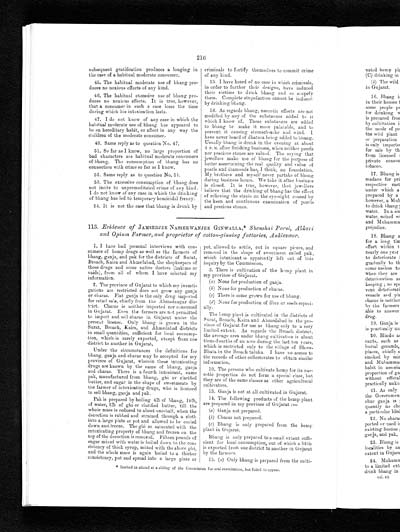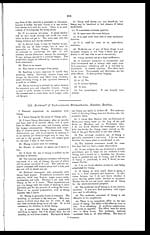Medicine - Drugs > Report of the Indian Hemp Drugs Commission, 1894-1895 > Volume VII > Evidence of Bombay witnesses
(234) Page 216
Download files
Individual page:
Thumbnail gallery: Grid view | List view

216
subsequent gratification produces a longing in
the case of a habitual moderate consumer.
45. The habitual moderate use of bhang pro-
duces no noxious effects of any kind.
46. The habitual excessive use of bhang pro-
duces no noxious effects. It is true, however,
that a consumer in such a case loses the time
during which his intoxication lasts.
47. I do not know of any case in which the
habitual moderate use of bhang has appeared to
be an hereditary habit, or affect in any way the
children of the moderate consumer.
48. Same reply as to question No. 47.
51. So far as I know, no large proportion of
bad characters are habitual moderate consumers
of bhang. The consumption of bhang has no
connection with crime so far as I know.
52. Same reply as to question No. 51.
53. The excessive consumption of bhang does
not incite to unpremeditated crime of any kind.
I do not know of any case in which the drinking
of bhang has led to temporary homicidal frenzy.
54. It is not the case that bhang is drunk by
criminals to fortify themselves to commit crime
of any kind.
55. I have heard of no case in which criminals,
in order to further their designs, have induced
their victims to drink bhang and so stupefy
them. Complete stupefaction cannot be induced
by drinking bhang.
56. As regards bhang, narcotic effects are not
modified by any of the substances added to it
which I know of. These substances are added
to bhang to make it more palatable, and to
prevent it causing stomach-ache and wind. I
have never heard of dhatura being added to bhang.
Usually bhang is drunk in the evening at about
4 P.M after finishing business, when neither pearls
nor precious stones are valued. The saying that
jewellers make use of bluing for the purpose of
better ascertaining the real quality and value of
pearls and diamonds has, I think, no foundation.
My brothers and myself never partake of bhang
during business hours. We take it after business
is closed. It is true, however, that jewellers
believe that the drinking of bhang has the effect
of relieving the strain on the eye-sight caused by
the keen and continuous examination of pearls
and precious stones.
113. Evidence of JAMSEDJEE NASSERWANJEE GINWALLA,* Shenshai Parsi, Abkari
and Opium Farmer, and proprietor of cotton-ginning factories, Ankleswar.
1. I have had personal interviews with con-
sumers of hemp drugs as well as the farmers of
bhang, ganja, and pak for the districts of Surat,
Broach, Kaira and Ahmedabad, the shopkeepers of
those drugs and some native doctors (hakims or
vaids), from all of whom I have selected my
information.
2. The province of Gujarat to which my investi-
gations are restricted does not grow any ganja
or charas. Flat ganja is the only drug imported
for retail sale, chiefly from the Ahmednagar dis-
trict. Charas is neither imported nor consumed
in Gujarat. Even the farmers are not permitted
to import and sell charas in Gujarat under the
present license. Only bhang is grown in the
Surat, Broach, Kaira, and Ahmedabad districts
in small quantities, sufficient for local consump-
tion, which is rarely exported, except from one
district to another in Gujarat.
Under the circumstances the definitions for
bhang, ganja and charas may be accepted for my
province of Gujarat, wherein these intoxicating
drugs are known by the name of bhang, ganja
and charas. There is a fourth intoxicant, name
pak, manufactured from bhang, ghi or clarified
butter, and sugar in the shape of sweetmeats by
the farmer of intoxicating drugs, who is licensed
to sell bhang, ganja and pak.
Pak is prepared by boiling 4lb of bhang, 10lb,
of water, 2lb of ghi or clarified butter, till the
whole mass is reduced to about one-half, when the
decoction is rubbed and strained through a cloth
into a large plate or pot and allowed to be cooled
down and freeze. The ghi so saturated with the
intoxicating property of bhang and frozen on the
top of the decoction is removed. Fifteen pounds of
sugar mixed with water is boiled down to the con-
sistency of thick syrup, mixed with the above ghi,
and the whole mass is again boiled to a thicker
consistency, put and spread into a large plate or
pot, allowed to settle, cut in square pieces, and
removed in the shape of sweetmeat called pak,
which intoxicant is apparently left out of this
inquiry by the Commission.
3. There is cultivation of the hemp plant in
my province of Gujarat.
(a) None for production of ganja.
(b) None for production of charas,
(c) There is some grown for use of bhang.
(d) None for production of fibre or seeds especi-
ally.
The hemp plant is cultivated in the districts of
Surat, Broach, Kaira and Ahmedabad in the pro-
vince of Gujarat for use as bhang only to a very
limited extent. As regards the Broach district,
the average area under bhang cultivation is about
three-fourths of an acre during the last ten years,
which is restricted only to the village of Bhore-
Bhata in the Broach taluka. I have no access to
the records of other collectorates to obtain similar
information.
10. The persons who cultivate hemp for its nar-
cotic properties do not form a special class, but
they are of the same classes as other agricultural
cultivators.
13. Ganja is not at all cultivated in Gujarat.
14. The following products of the hemp plant
are prepared in my province of Gujarat: —
(a) Ganja not prepared.
(b) Charas not prepared.
(c) Bhang is only prepared from the hemp
plant in Gujarat.
Bhang is only prepared to a small extent suffi-
cient for local consumption, out of which a little
is exported froth one district to another in Gujarat
by the farmers.
15. (a) Only bhang is prepared from the culti-
* Invited to attend at a sitting of the Commission for oral examination, but failed to appear.
Set display mode to: Large image | Zoom image | Transcription
Images and transcriptions on this page, including medium image downloads, may be used under the Creative Commons Attribution 4.0 International Licence unless otherwise stated. ![]()
| India Papers > Medicine - Drugs > Report of the Indian Hemp Drugs Commission, 1894-1895 > Volume VII > Evidence of Bombay witnesses > (234) Page 216 |
|---|
| Permanent URL | https://digital.nls.uk/74911251 |
|---|




